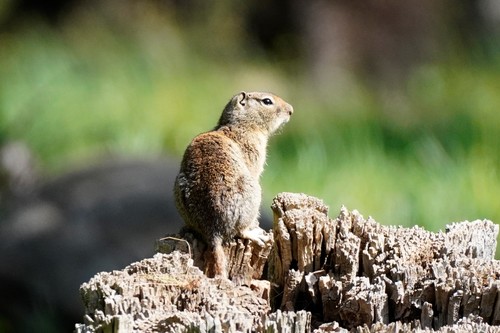Recent Sagehen Basin discoveries...
Summer 2021 has been a great one for new Sagehen discoveries by iNaturalists! Here are a few of the stand-outs. One thing that is interesting is how many of these sudden occurrences of new animals and plants could be related to the Sagehen Forest Project thinning and prescribed fire treatments in the basin:
- Belding's Ground Squirrel (Urocitellus beldingi): while formerly common in the basin and the subject of study in the 1980's, these squirrels vanished from Sagehen until @chrisophylla photographed one this summer: the first time they've been reported in 40 years.
- Threeleaf Lewisia (Lewisia triphylla): we also have chrisophylla to thank for locating the first example of these lovely flowers since the 1970's. Back then, 1/3 of the basin was recovering from the stand-replacing 1960 Donner Ridge fire; chrisophylla found this plant in an area where Sagehen Forest Project thinning had occurred, so the treatments to create openings in the forest would seem to be releasing plants as hoped! Maybe that's also why the Belding's Ground Squirrel showed up? Central Sierran east-slope conifer forests, lovely as they are, will choke out everything else--including other trees--without regular, low-intensity fire to keep the stands healthy, diverse, and resilient.
- Morels (Morchella snyderi): these mushrooms are uncommon at Sagehen and this is the first iNat ob of a true morel in many years. But they are known to be released by forest fire in pine forests...again, perhaps a result of recent prescribed fire in the basin?
- Ferruginous Hawk (Buteo regalis): this hawk was spotted at Sagehen by @nhbirdlaw, despite never having been reported in the basin in the past. It's not even on the species list of suspects. The hawk *is* on the Nevada County species list, so they've never been too far away. These raptors generally feed on squirrels and other rodents (though they'll also eat snakes, birds and other prey). Perhaps the Belding's Ground Squirrels aren't the only prey species on the upswing (or moving higher)?
-
Rocky Mountain Wood Tick (Dermacentor andersoni): and finally, some potentially less good news. Rocky Mountain Wood Ticks are rare in CA, but found consistently in several high Sierra locations, including along Lower Sagehen Creek below HWY-89. Here's some information from @megsquitophd, who found the tick:
These ticks haven't been tested by CDPH (yet) but will be in the future for Colorado Tick Fever Virus. The CDPH-VBDS 2020 annual report will be published soon for the most up to date testing information on infection rates in different counties. Other site of interest for TBD's would be https://www.cdph.ca.gov/Programs/CID/DCDC/Pages/Tick-Borne-Diseases.aspx. If interested in Lyme disease specifically we have an interactive Lyme Disease story map.
Erica and I have also spent lots of time and energy this year getting our Sagehen Collections digitization projects wrapped up. As part of that effort, I've updated the Sagehen Flora taxonomy and content, so our plant list should be very current and accurate at this point, and a very useful tool for identifying plants in the basin.

Photo of Belding's Ground Squirrel at Sagehen by chrisophylla, 2021.
UPDATE: a mustard observed along Sagehen Creek in 2016 has finally been identified as Lepidium campestre. This is a new species to the basin and it's an interesting one, even though a weed. The plant is edible as a green or a spice, and can grow productively in virtually any soil, even degraded ones and those within a few dozen kilometers of the Arctic Circle. The species is being studied in Sweden as a food and oil plant for the far north.





Comments
Add a Comment